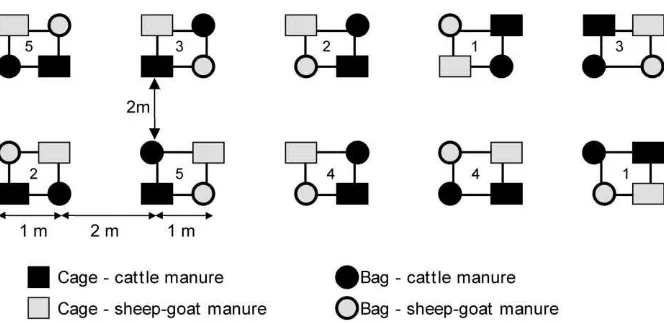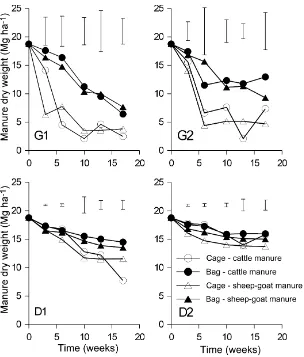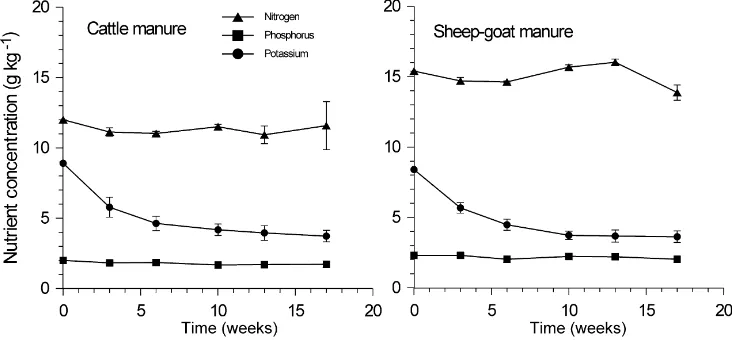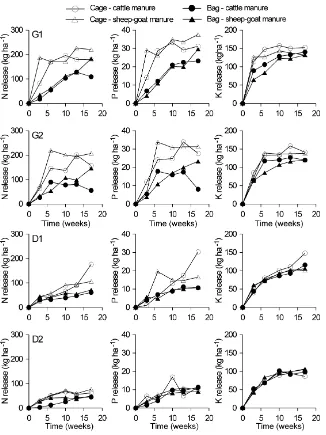Decomposition of and nutrient release from ruminant manure on
acid sandy soils in the Sahelian zone of Niger, West Africa
P.C. Esse
a, A. Buerkert
b,∗, P. Hiernaux
c, A. Assa
a aUnité de Formation et de Recherche des Sciences de la Terre et des Ressources Minières,Université de Cocody, 22 BP 582, Abidjan 22, Ivory Coast
bInstitute of Plant Nutrition (330), University of Hohenheim, Steinstr. 19, D-37213 Witzenhausen, Germany cInternational Livestock Research Institute (ILRI), International Crops Research Institute for the Semi-Arid Tropics (ICRISAT)
Sahelian Centre, BP 12404, Niamey, Niger
Received 31 December 1999; received in revised form 8 May 2000; accepted 29 August 2000
Abstract
In ago-pastoral systems of the semi-arid West African Sahel, targeted applications of ruminant manure to the cropland is a widespread practice to maintain soil productivity. However, studies exploring the decomposition and mineralisation processes of manure under farmers’ conditions are scarce. The present research in south-west Niger was undertaken to examine the role of micro-organisms and meso-fauna on in situ release rates of nitrogen (N), phosphorus (P) and potassium (K) from cattle and sheep–goat manure collected from village corrals during the rainy season. The results show that (1) macro-organisms played a dominant role in the initial phase of manure decomposition; (2) manure decomposition was faster on crusted than on sandy soils; (3) throughout the study N and P release rates closely followed the dry matter decomposition; (4) during the first 6 weeks after application the K concentration in the manure declined much faster than N or P. At the applied dry matter
rate of 18.8 Mg ha−1, the quantities of N, P and K released from the manure during the rainy season were up to 10-fold larger
than the annual nutrient uptake of pearl millet (Pennisetum glaucumL.), the dominant crop in the traditional agro-pastoral
systems. The results indicate considerable nutrient losses with the scarce but heavy rainfalls which could be alleviated by smaller rates of manure application. Those, however, would require a more labour intensive system of corralling or manure distribution. © 2001 Elsevier Science B.V. All rights reserved.
Keywords:Corralling; Manure; Millet; Niger; Nutrient release; Termites
1. Introduction
In the West African Sahel, bush fallow systems have traditionally helped to restore the productivity of repeatedly cropped acid sandy soils. Fallow periods between 10 and 30 years allowed (1) the enrichment of
∗Corresponding author. Present address: Institute of Crop Sci-ence, University of Kassel, Steinstr. 19, D-37213 Witzenhausen, Germany. Tel.:+49-5542-98-1228; fax:+49-5542-98-1230.
E-mail address:[email protected] (A. Buerkert).
the topsoil with mineral nutrients and organic carbon by diazotrophic N2-fixation from the herbaceous layer
or shrubs in the order 5–10 kg N ha−1per year, and the
decay products of between 400 and 500 kg ha−1 per
year of leaf, twig and fruit products of woody plants (Hiernaux, 1983; Krul et al., 1982); (2) the transfer of minerals from deeper soil layers and their recycling with falling leaves; (3) the capture of bird droppings estimated at up to 40 kg DM ha−1per year containing
2.2 kg N, 0.4 kg P and 0.7 kg K (Soumaré, 1995), and (4) the deposition of substantial amounts of base-rich
has become crucial to the sustained productivity of Sahelian farming systems.
Under farmers’ conditions, increases of millet grain yield per tonne dry matter of applied manure vary from 15 to 86 kg (McIntire et al., 1992). While it is evident that manure application does not add nutrients to the agro-pastoral system as a whole, but merely is a means to transfer minerals and organic carbon at different scales (Hiernaux et al., 1997; Buerkert and Hiernaux, 1998), the high demand for manure by millet farmers is reflected in elaborate agreements with pastoral herders who exchange manure for grain and grazing rights on harvested millet fields. The strong decrease in the ra-tio of grazing land to cropping land in most of Africa stimulated research to optimise farmers’ traditional manure application strategies by decreasing unproduc-tive losses (Murwira et al., 1995; Brouwer and Powell, 1998). In the Sahel, manure rates of over 10 Mg ha−1
per year have been reported for the typical confined ar-eas (corrals) of 10–20 m in diameter close to farmers’ homesteads in the cropland, whereas application rates in uncorraled manured fields average 1.5 Mg ha−1
(Powell and Williams, 1993). Given the low buffering capacities of the predominantly acid sandy soils, this uneven distribution of manure contributes to a marked pattern of variability in crop growth short distances (microvariability) often described as characteristic for the Sahel (Brouwer et al., 1993; Buerkert et al., 1996). That manure application at high rates can lead to considerable leaching losses of nutrients on sandy soils has been concluded by Brouwer and Powell (1995) from a trial under controlled conditions.
Given the range of rainfall intensities and termite activities in Sudano–Sahelian West Africa, more on-farm studies are needed to determine the pattern
The experiment was conducted at Chikal (3◦26′E, 14◦14′N), a village 170 km north of Niamey, the capi-tal of Niger, on fields in a palaeo valley called ‘Dallol Bosso’ with alluvial Arenosols (Projet Tapis Vert, 1977). With an average annual rainfall of 350 mm, Chikal is climatically at the northern border of the ‘Southern Sahelian Zone’ which is characterised by a 9-month dry season from September to May, and a 3-month rainy season lasting from June to August. The long-term (1986–1997) mean annual temperature is 30◦C.
Four farmer-fields were chosen as trial sites based on differences in their topographic position and the quantity of active mounds of harvester-type macroter-mitidae. These termites are able to carry bits of or-ganic material larger then themselves to their often distant and partly underground nests. Two sites were in the valley bottom (‘Dallol’; D1 and D2) on loose sandy soils with low presence of termite mounds, and two sites were at the eroded bottom of the lateral hills (‘Glacis’; G1 and G2) on soils with a slope of about 1%, a surface crust of between 10 and 20 mm thick-ness and a higher apparent presence of termites.
Animal manure mixed with minor amounts of bedding and feed refusals from different cattle and sheep–goat corrals in the village was collected in May 1997, mixed within faeces type and dried in the sun. At the onset of the rainy season (2–4 June) the dry ma-nure was placed in metallic cages with 4 mm mesh on the soil surface permitting easy access of meso-fauna such as termites, beatles or arthropods. To study de-composition processes without meso-fauna but with bacteria, protozoa and nematodes, transparent nylon bags with 100mm mesh were used. Manure
Fig. 1. Experimental layout of an experimental block in each of the four farmer-fields at Chikal, south-west Niger, 1997. Note that each block contains two replicates of each treatment (statistically considered as subsamples) to account for short distance variation in manure decomposition. Numbers from 1 to 5 indicate the respective collection periods of 3, 6, 10, 13 and 17 weeks after manure application.
surface of 0.4 m2 equivalent to an application rate of 18.8 Mg ha−1. This manure load may appear high but it is still below the maximum of 30 Mg ha−1found in farmers’ fields by Powell et al. (1996). The 20 treat-ments in each of the three blocks per field comprised factorial combinations of: (1) two types of manure (that is, manure of cattle and manure of sheep–goat); (2) two types of container with or without access of meso-fauna (that is, metallic cage or nylon bag); and (3) five dates of sample collection at 3, 6, 10, 13 and 17 weeks after manure application. To account for termite-induced short distance spatial variability in de-composition rates, the 20 treatment units were laid out twice in each block in rows of 2 m distance (Fig. 1).
2.2. Data collection and analysis
Upon sample collection, the remaining quantity of manure was cleaned with a brush to remove loosely adhering soil particles. At all sites, manure samples were oven-dried to constant weight at 55◦C to deter-mine total dry matter. Initial and all subsequent ma-nure samples were ground to 2 mm to analyse N by colorimetry, P by colorimetry with ascorbic acid and K by flame emission spectrophotometry (Walinga et al., 1995). Subsamples were dry-ashed in an oven for 5 h at 500◦, therefore all results are based on organic mat-ter. To limit the number of chemical analyses, only samples from the G2 site were analysed separately for all dates, manure and container types in each of
the three blocks. The samples from each of the three other sites were analysed separately for dates, manure and container types but averaged across blocks. Ma-nure disappearance was calculated as the difference between initial manure weight (organic matter basis) and manure weight at the respective date. The same procedure was used to determine nutrient release. All dry matter data were subjected to analysis of variance using GENSTAT® 5 Release 3.2 (Lawes Agricultural Trust, 1993) and at each site treatment means were plotted to derive curves of organic matter disappear-ance and nutrient release. Time-related changes in nu-trient concentrations were plotted with their respective standard errors of the mean. Disappearance of manure organic matter was expressed as a percentage of the initial rate applied. Nutrient concentrations in similar datasets were not normally distributed, butF-values of log-transformed data did not significantly differ from those of untransformed data (Buerkert et al., 1998). For improved readability all data in this study are re-ported untransformed with the understanding that the respectiveF-probabilities are only approximate.
3. Results and discussion
3.1. Manure disappearance
Sheep–goat 49.0 146 23 120
D1 Cage Cattle 59.8 176 30 148
Sheep–goat 36.6 106 17 101
Bag Cattle 21.1 61 11 116
Sheep–goat 25.9 71 11 106
D2 Cage Cattle 17.0 62 11 86
Sheep–goat 24.4 76 10 105
Bag Cattle 13.1 45 11 98
Sheep–goat 17.7 50 9 107
Analysis of variance F-probability
Site <0.001 <0.001 <0.001 <0.001
Container <0.001 <0.001 <0.001 0.041
Manure 0.766 0.020 0.687 0.059
Site×container 0.383 0.339 0.106 0.109
Site×manure 0.231 0.017 0.035 0.004
Container×manure 0.424 0.265 0.263 0.180
effects on the decomposition (as indicated by the organic matter disappearance) of both manure types (Table 1; Fig. 2). With meso-fauna (in cages) and averaged across both types of manure, on the crusted ‘Glacis’ soils with large termite presence as evidenced by a larger number of mounts per area compared to ‘Dallol’ soils, 75% of the applied manure disappeared during the first 10 weeks after application. This com-pares to a disappearance rate of only 28% on the loose ‘Dallol’ soils. Without meso-fauna (in nylon bags) manure decomposition at 10 weeks was much lower being 38% on ‘Glacis’ soils and 16% on ‘Dallol’ soils. These differences remained unchanged throughout the rest of the study period and demonstrated the impor-tant role of meso-fauna in the decomposition process in this environment. The higher termite activity on the crusted ‘Glacis’ sites may be linked to the heavier texture of their more wind- and water-eroded surface
soil compared to the lighter textured soil surfaces of the ‘Dallol’ sites, although no analysis of particle size distribution such as reported by Buerkert et al. (2000) for mulched and unmulched surface soils in the same area was performed to verify texture differences in this study. Boyer (1975) and Bachelier (1978) ob-served that a critical level of 100 g kg−1clay and silt
Fig. 2. Organic matter disappearance of cattle and sheep–goat manure applied in metallic cages of 4 mm mesh or in nylon bags of 100mm
mesh placed on the soil surface between 2 and 4 June 1997 at four sites in Chikal, south-west Niger. The eroded ‘Glacis’ sites G1 and G2 had crusted, the sandy ‘Dallol’ sites D1 and D2 loose topsoils. Vertical bars represent±1 S.E. of the difference of means.
manure or crop residues to crusted topsoils, is thus an effective but labour intensive method of soil reclama-tion and rehabilitareclama-tion, which as such is also widely practised by local farmers on the generally untilled soils of the Northern Sahel (Feil and Lamers, 1996).
There were no significant differences in disappear-ance rates between the two types of manure regardless of container or soil type. This is in contrast to results by Powell et al. (1998) obtained at a site further south in Niger with 560 mm average annual rainfall. With termite access they reported a complete disintegration and disappearance of cattle manure within less than 3 months compared to a 13.8% recovery of sheep dung after 12 months.
refusals and left in the sun unprotected against am-monia volatilisation, whereas the faeces of Brouwer and Powell (1998) were mixed with urine right at the trial site. Initial N concentrations were higher in sheep–goat manure than in cattle manure which con-firms findings of Brouwer and Powell (1998), Landais and Lhoste (1993) and Schleich (1986), but there were only minor differences between manure types for P and K concentrations (Fig. 3). Phosphorus concentra-tions of 2 g kg−1and K concentrations of 9 g kg−1for
cattle and 8 g kg−1 for sheep–goat manure were
sim-ilar to those reported by Landais and Lhoste (1993) and Schleich (1986). Under on-farm conditions, the observed differences in N concentrations between ma-nure types may be due to differences in the feed and
Fig. 3. Average decline of nitrogen (N), phosphorus (P) and potassium (K) concentration in cattle and sheep–goat manure during the first 17 weeks after manure application at the onset of the rainy season at four sites in Chikal, south-west Niger. Wherever larger than the symbol, vertical bars represent±1 S.E. of the mean.
riod, K concentrations in both manure types rapidly dropped during the first 6 weeks and stabilised there-after (Fig. 3). Consequently, N and P liberation mir-rored dry matter disappearance, whereas K release was much larger in the first weeks after manure ap-plication likely reflecting the higher water solubility of this nutrient compared to N and P (Fig. 3). After 17 weeks, liberation of N, P and K with meso-fauna was with 198 kg N ha−1 1.9 times, with 32 kg P ha−1
1.9 times and with 141 kg K ha−11.3 times higher on
Fig. 4. Cumulative release of nitrogen (N), phosphorus (P) and potassium (K) over 17 weeks at four sites (‘Glacis’ sites G1 and G2 had crusted, ‘Dallol’ sites D1 and D2 loose sandy topsoils) for cattle and sheep–goat manure placed at the onset of the rainy season 1997 in metallic cages or nylon bags at Chikal, south-west Niger.
larger quantities of N and K than cattle manure but release of P was similar (Table 1).
Overall the quantities of nutrients released during the 17 weeks of this study were much larger than the nutrient demand of landrace millet under farmers’ moisture-induced low plant densities between 3000 and 5000 hills ha−1. With these densities total crop
nutrient uptake may reach between 21 kg N ha−1, 1.7 kg P ha−1 and 35 kg K ha−1 at 300 kg grain and 1700 kg straw and 28 kg N ha−1, 2.3 kg P ha−1 and
37 kg K ha−1 at 500 kg grain and 2300 kg straw
poor plant growth seem more severe, even if it may at the watershed level merely lead to a transfer of nutrients to nearby deposition sites (Buerkert and Hiernaux, 1998). Moreover, at least in the short run, considerable amounts of mineral nutrients that had disappeared from applied manure may have been se-questered in the termite mounts themselves and will only be released once the mounts are destroyed or abandoned.
4. Conclusions
Under the conditions of low rainfall and high ter-mite activity at this Sahelian site most of the manure disappearance during the rainy season occurred very quickly (Fig. 2). Despite large nutrient losses due to high manure loads on selected spots of croplands, labour constraints and erratic availability of nomadic livestock may make it difficult for farmers to replace the current practice of prolonged corralling of animals on the same spot by more widespread applications of manure to their fields. This is not valid, though, for the manual spread of manure from permanent village cor-rals, which is to maximise nutrient uptake by plants, should be applied only about 4 weeks after sowing. Annual manure application at rates of 2–3 Mg ha−1
rather than large ‘once-in-10-year applications’ could in principle help to reduce nutrient losses at the field level. Manure application is an effective yield enhancing method to recycle nutrients from crop residues over short distances in the field or to transfer nutrients from rangeland to cropland. As such it cer-tainly merits further research to quantify climate- and soil-related differences in nutrient release and uptake
The authors are grateful to F. Mahler, E. Schlecht, B. Buerkert, R.D. Stern, T. Winkel and J.M.K. Am-bouta for their collaboration and advice, to B. Gérard for his critical comments, to ICRISAT Sahelian Cen-tre for infrastructural support and to the Deutsche Forschungsgemeinschaft (SFB 308) for funding.
References
Bachelier, G., 1978. La faune du sol, son action. Editions de l’ORSTOM, Paris, France, 391 pp.
Berger, M., 1996. Les règles pratiques de la fumure organique. Fiche technique numéro 6. In: Agriculture et développement, No. H.S. Département des cultures annuelles du Centre de Coopération Internationale en Recherche Agronomique pour le Développement (CIRAD-CA), Montpellier, France, 8 pp. Boyer, P., 1975. Les différents aspects de l’action des
Bellicositermessur les sols tropicaux. Ann. Sci. Nat. 17, 447– 504.
Brouwer, J., Powell, J.M., 1995. Soil aspects of nutrient cycling in a manure application experiment in Niger. In: Powell, J.M., Fernandez-Rivera, S., Williams, T.O., Renard, C. (Eds.), Livestock and Sustainable Nutrient Cycling in Mixed Farming Systems of Sub-Saharan Africa. International Livestock Centre for Africa (ILCA), Addis Ababa, Ethiopia, pp. 211–226. Brouwer, J., Powell, J.M., 1998. Increasing nutrient use efficiency
in West-African agriculture: the impact of micro-topography on nutrient leaching from cattle and sheep manure. Agric. Ecosyst. Environ. 71, 229–239.
Brouwer, J., Fussell, L.K., Herrmann, L., 1993. Soil and crop growth micro-variability in the West African semi-arid tropics: a possible risk-reducing factor for subsistence farmers. Agric. Ecosyst. Environ. 45, 229–238.
Buerkert, A., Hiernaux, P., 1998. Nutrients in the West African Sudano–Sahelian zones: losses, transfers and role of external inputs. J. Plant Nutr. Soil Sci. 161, 365–383.
Buerkert, A., Haake, C., Ruckwied, M., Marschner, H., 1998. Phosphorus application affects the nutritional quality of millet grain in the Sahel. Field Crops Res. 57, 223–235.
Buerkert, A., Bationo, A., Dossa, K., 2000. Mechanisms of residue mulch induced cereal growth increases in West Africa. Soil Sci. Soc. Am. J. 64, 346–358.
Feil, P., Lamers, J.P.A., 1996. Farmers’ perceptions about wind erosion and its control. In: Buerkert, B., Allison, B.E., von Oppen, M. (Eds.), Wind Erosion in Niger. Implications and Control Measures in a Millet-based Farming System. Kluwer Academic Publishers, Dordrecht, the Netherlands, pp. 215–231.
Hafner, H., George, E., Bationo, A., Marschner, H., 1993. Effect of crop residues on root growth and nutrient acquisition of pearl millet in an acid sandy soil in Niger. Plant and Soil 150, 117–127.
Herrmann, L., Sponholz, B., Stahr, K., 1994. Quellregionen für den Harmattan-Staub in Westafrika: Ein mineralogischer und geochemischer Ansatz. Mitt. Deutsch. Bodenk. Gesell. 74, 367– 370.
Hiernaux, P., 1983. Les ressources végétales et leur productivité. In: Wilson, R.T., de Leeuw, P.N., De Haan, C. (Eds.), Recherches sur les systèmes des zones arides du Mali: résultats préliminaires. Research Report No. 5. International Livestock Centre for Africa (ILCA), Addis Ababa, Ethiopia, pp. 28–50. Hiernaux, P., Fernández-Rivera, S., Schlecht, E., Turner, M.D.,
Williams, T.O., 1997. Livestock-mediated nutrient transfers in Sahelian agro-ecosystems. In: Renard, G., Neef, A., Becker, K., von Oppen, M. (Eds.), Soil Fertility Management in West African Land Use Systems. Margraf Verlag, Weikersheim, Germany, ICRISAT, INRAN, University of Hohenheim and Niamey, Niger, pp. 339–347.
Krul, J.M., Penning de Vries, F.W.T., Traoré, F., 1982. Le processus du bilan d’azote. In: Penning de Vries, F.W.T., Djitèye, M.A. (Eds.), La productivité des pâturages sahéliens. Une etude des sols, des végétations et de l’exploitation de cette ressource naturelle. Pudoc, Wageningen, the Netherlands, pp. 226–246. Landais, E., Lhoste, P., 1993. Systèmes d’élevage et transferts de
fertilité dans la zone des savanes africaines. 2. Les systèmes de gestion de la fumure animale et leur insertion dans les relations entre l’élevage et l’agriculture. Cahier d’Etudes et de Recherche Francophones Agriculture, Vol. 2. Institut National de la Recherche Agronomique (INRA), Centre de Versailles, France, pp. 9–25.
Lawes Agricultural Trust, 1993. GENSTAT 5 Release 3 Reference Manual. Oxford University Press, Oxford.
Mando, A., Stroosnijder, L., Brussaard, L., 1996. Effects of termites on infiltration into crusted soil. Geoderma 74, 107–113.
McIntire, J., Bourzat, D., Pingali, P., 1992. Crop–Livestock Interaction in Sub-Saharan Africa. The World Bank, World Bank, Regional and Sectoral Studies, Washington, DC, 246 pp. Murwira, K.H., Swift, M.J., Frost, P.G.H., 1995. Manure as a key resource in sustainable agriculture. In: Powell, J.M., Fernandez-Rivera, S., Williams, T.O., Renard, C. (Eds.), Livestock and Sustainable Nutrient Cycling in Mixed Farming Systems of Sub-Saharan Africa. International Livestock Centre for Africa (ILCA), Addis Ababa, Ethiopia, pp. 131–148. Powell, J.M., Williams, T.O., 1993. Livestock, nutrient cycling and
sustainable agriculture in the West African Sahel. Gatekeeper Series SA37. International Institute for Environment and Development (IIED), London, 15 pp.
Powell, J.M., Fernandez-Rivera, S., Hiernaux, P., Turner, M.D., 1996. Nutrient cycling in integrated rangeland/cropland systems of the Sahel. Agric. Syst. 52, 143–170.
Powell, J.M., Ikpé, F.N., Somda, Z.C., Fernandez-Rivera, S., 1998. Urine effects on soil chemical properties and the impact of urine and dung on pearl millet yield. Expl. Agric. 34, 259–276. Projet Tapis Vert, 1977. Compte rendu des études préliminaires et des recherches réalisées à Chikal, Vol. 1. International Livestock Centre for Africa (ILCA), Addis Ababa, Ethiopia, Institute for the Study and Application of Integrated Development, Ont., Canada, 21 pp.
Schlecht, E., Fernandez-Rivera, S., Hiernaux, P., 1997. Timing, size and N-concentration of faecal and urinary excretions in cattle, sheep and goats: can they be exploited for better manuring of cropland? In: Renard, G., Neef, A., Becker, K., von Oppen, M. (Eds.), Soil Fertility Management in West African Land Use Systems. Margraf Verlag, Weikersheim, Germany, ICRISAT, INRAN, University of Hohenheim and Niamey, Niger, pp. 361–367.
Schleich, K., 1986. Le fumier peut-il remplacer la jachère? Possibilité d’utilisation du fumier: exemple de la savane d’Afrique occidentale. Revue d’Elevage et de Médecine Vétérinaire des Pays Tropicaux, Vol. 39. Institut d’Elevage et de Médecine Vétérinaire des Pays Tropicaux (IEMVT), Maisons-Alfort, France, pp. 97–102.
Soumaré, A., 1995. Utilisation des elements nutritifs par deux arbres du Sahel: Acacia seyal et Sclerocarya birrea. Thèse Doc. ISFRA, Spec., Bamako, Mali, 137 pp.
van Reuler, H., Prins, W.H., 1993. The Role of Plant Nutrients for Sustainable Food Crop Production in Sub-Saharan Africa. Vereniging van Kunstmest Producenten, Leidschendam, the Netherlands, 259 pp.




